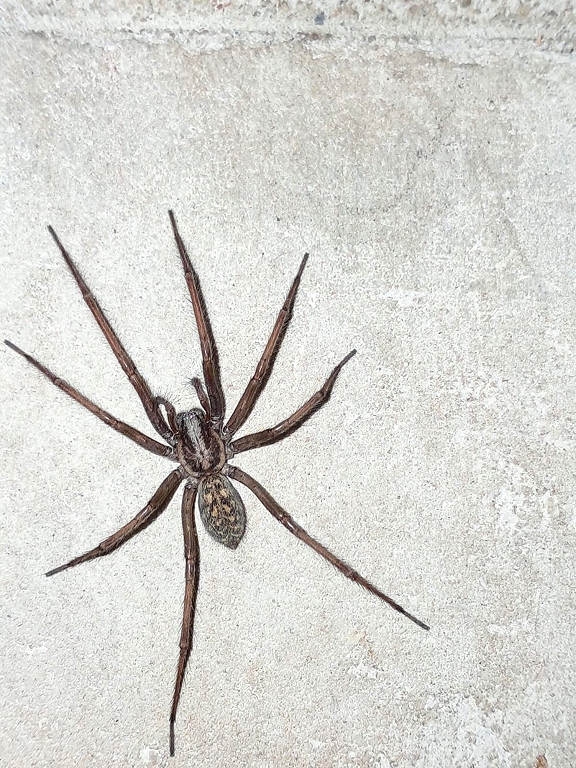Sub -tenant in our homes / day

Taking attention to the importance of our own home -based invertebrates in maintaining the environment, this year the Latvian Entomological Society has appointed a great home spider in honor of the invertebrate of 2025 Eratigena Atrica. Although sometimes considered an unnoticed sub -tenant, the great home spider in a human home is reducing a person worried about the presence of other insects.
Almost eight centimeters
It is not for nothing that this hero has a greatness in the name. Indeed, this invertebrate, who also tends to live in a very secret in a corner of our home, can surprise the ignorant with its size. Although the female body can reach less than two centimeters, measuring the spider with the legs, its length stretches in less than eight centimeters. In addition, the spider's legs tend to be three times longer than its body. The yellowish -gray, solid -colored Ejkāja – a total of eight – is attached to the head.
The big home spider can be recognized even after a few more significant details. Its head is yellowish -gray with lines on the surface, while the bottom of the chest is with a lighter band in the middle and three points on each side. The belly spider is gray brown, its top has two longitudinal yellowish dots and also a light heart sign.
Despite the great size of the year's hero, it is also able to live in one place with other home -made spider species, as long as the house, garage, basement or any other place is large enough. According to Inese Cera and Voldemārs Spuņģis, the other species of the funnel spider family, which also inhabits human housing, is according to Entomological Society. Tegenaria Domestica. To distinguish one species from the other, look at the feet. If its spider is striped then it is Tegenaria DomesticaIf monochrome is the great home spider. We can also meet in the dwelling. Pholcus Phalangoides And the fake widow Steatoda Grossa – they are both smaller than the funnel. «In the autumn, the house can also be entered by wheels, blankets, a wolfwear or a jumping bracket. If you have firewood heating at home, other spiders can also be hidden in firewood, »says entomologists.
The world
Although there are two lines in front of the spider's head, there are eight eyes in front of the spider, its invertebrate is not the main « mechanism » of information perception. According to spider researcher or arachnologist Inese Cera, a researcher at the Institute of Biology, University of Latvia, the Faculty of Medicine and Life Sciences, vision of the great home spider is poorly developed: « This spider sees darkness and light, possibly shadows and movements when a spider approaches. I assume that more information is read by the spider with its feet. They have specialized hair that feels vibration in the environment. The spider feels the environment and movements in it with the help of a touch. »
Is there a reason to be afraid of such a newly discovered neighbor's own apartment? Entomologists point out that, most often, the spider himself will avoid communication by hurrying to hide in fear of possible « eviction » threats. However, if a person is carelessly picked up or even squeezed, the great home spider can also bite, leaving a temporary consequence at the bite site, such as a bloating, which should be taken within a few hours.
Where warm and where the meal
So how can we know that we can not have a invertebrate of 2025 in our home for a long time? «The great home spider is an animal that is active at night. Then there is more activity. Being in the light, the spider is at greater risk of being caught, »emphasizes I. Cera. However, if we disturb the spider during the daytime time, it is likely to move to find a new hiding place.
The Great Home Spider of our Housing Understands becomes the good living conditions: there is a constant, warm climate and food. Usually the spider is dedicated to rooms that enter less frequently, for example, in the bathroom, the attic, the basement, the garage, as long as there is warm enough. In the open air, the spider is found in warmer climate zones where caves and dry forests inhabit. The spider's menu includes other home -based insects, the presence of which in their living space is usually not excited, including moths, beetles, flies, mosquitoes. Entomologists of the Latvian Entomological Society emphasize that, despite many feelings so uncomfortable with spiders, it should be borne in mind that they are also important regulators for insects.
Females on the network can spend as much as their two to three years, while males are travelers. Between June and August, males are looking for females to mate. True, the males are then killed or eaten. Young spiders, whose development is more successful at stable ambient temperatures (22-25 degrees), slides once a year – at the end of August, September. Then the young spiders spend another month and then dissipate it elsewhere.
The fact that the spider has been living in or recently has been evidenced by its networks, but not what we usually see in children's books. There we see more often round, wheel -like webs that are usually made by wheels. (In addition, the wheels can weave their net at least every night and even eat their old creation to process protein.) The great home spider captures its meal using a funnel -like net formed in the corners of the room and slits. The entry network around it is flat, with chaotically located, non -stick web, but in the farthest part of the network, there is a tube that is likely to hide its owner, the spider. Unlike wheels, the funnels do not eat homemade old networks.
«If the spider has left the net, it is no longer used to obtain feed. It has lost its elasticity and does not fulfill its function – do not catch insects, »explains spider researcher I. Cera, encouraging reporting the spiders seen in their homes. If the Great Home Spider is observed, it should be said on the nature observation portal Dabasdati.lv or by contacting the experts of the Latvian Entomological Society by writing to e-mail (Email Protected). « We are also particularly awaiting news of the names given to the big home spider, because some people consider them to be fully -fledged by the names of the home, » adds the arachnologist.








